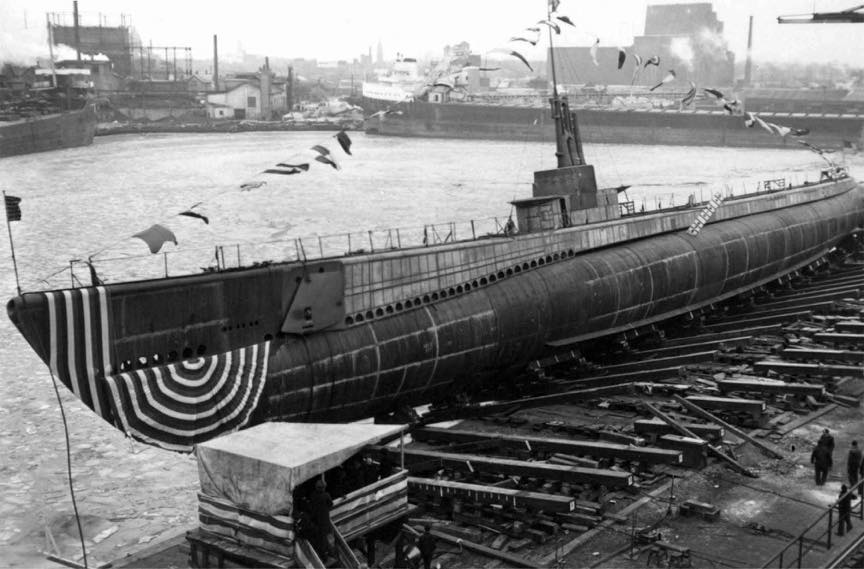Menhaden SS 377

(SS-377: dp. 1,526 (surf.), 2,424 (subm.); 1. 311'9"; b. 27'3"; dr. 1.''3", s. 201;. (surf.), 9 k. (subm.), cpl. 66; a. 1 ,)", 1 40mill., 10 21" tt.,; cl. Balao)
The second Menhaden (SS-377) was laid down by Manitowoc Shipbuilding Co., Manitowoc, Wis., 21 June 1944 launched 20 December 1944; sponxored by Miss Mirium R. Johnson and commissioned at Manitowac 22 June 1943, Comdr. David H McClintock in command.
Skippered by Commander McClintock and manned by sailors from the redoubtable Darter (SS-227), Menhaden, the last of the Manitowoc-built boats to have commissioned service during World War II, trained in Lake Michigan until 15 July. Thence, .she was floated down the Mississippi River to New Orleans \where she departed for the Canal Zone 27 July. She conducted extensive training out of Balboa during the closing days of the war against Japan and between 1 and 16 September cruised to Pearl Harbor for duty with SubRon 10.
On 24 November 31 Menhaden broke the flag of Fleet Adm. Chexter NV. Nimitz, CINCPAC and CINCPOA. Fleet Admiral Nimitz had selected Menhaden as his flagship during change of command ceremonies for she combined the new vith the old. Although untried in combat, she was one of the newest boats in the Submarine Service and incorporated the latest improvements in .submarine design and equipment. Moreover, her "gallantly battle-tested" crew epitomized the "valor, skill. and dedicated service of submariners" during the long Pacific war. Thus, on her deek that morning fleet Admiral Nimitz read his orders assigning him to duty as Chief of Naval Operations, and his relief, Adm. Raymond A. Spraunce. read orders makiing him CINCPAC and CINPOA.
Menhaden operated out of Pearl Harbor until 2 January 1946 when she sailed for the West coast, arriving San Francisco the 5th. Following inactivation overhaul nt Mare Island, she decommissioned 31 May 1946 and entered the Pacific Reserve Fleet. She recommissioned at Mare Island 7 August 1951, Lt. Comdr. Ralph G. Johns, Jr.. in command. Assigned to SubRon 3, she operated along the west coast out of San Diego during the next vear. She again decommissioned at Mare Island 13 August 1952 and began "Guppy IIA" overhaul and conversion to a snorkel submarine.
Menhaden recommissioned 6 March 1533, 1t. Comdr. William R. Werner in command. She Joined SubRon 3 at San Diego 12 June, and on 21 September shes xailed for the Far East. Operating out of Yokosuka she ranged the East and South China Seas until 11 February 1954 thence, she returned to San Diego 23 March. For the next year and a half she operated in the eastern Pacific where she participated in fleet readiness excersices and type training assignments. On 18 August 1955 xhe began her seconddeployment to WesPac where she joined and supported the ever-vigilant Taiwan patrol force. She returnel to the west coast 17 February 1956.
Since 1955 Menhaden has completed six more deployments in the troubled ivaters of the Far East. .\s a unit of SubDiv 32, she cruised the western Pacific from Japan and Tai\van to the PhililJpines and Australia. She carried out surveillance and reconnaissance patrols off past and present areas of cold war conflict from Korea to Vietnam. She has acted with skill, diligence, and dispatch while serving as both a weapon ofwar and an instrument of peace. Her valuable support of and contributions to the mighty 7th Fleet have holstered this versatile force which as the powerful seagoing arm of freedom of the Far East has contained communism and thwarted its spread in Southeast Asia.
When not deployed in the western Pacific, Menhaden has maintained a schedule of intellsive readiness and alert exercises. Home ported at San Diego, she has participated in numerous fleet and intertype exercises. In addition, she has .supported sonar school operations and has provided vital at sea training for membera of the Navy's Submarine Reserve Force.
Early in 1968 Menhaden returned to the western Pacific and gave visible meaning to the might of American seapower. During a 6-month deployment she concentrated her operations in the troubled waters of Southeast Asia as the United States increased the effort to protect and defense the independence and integrity of South Vietnam from aggression of the North V ietnamese Communists. Later in the year she returned to the west coast where she continued to prepare for future "keeping-the-peace" missions. Into 1969 her training and deployments remain vital to the defense of the inactivation and the free world and clearly demonstrate to friend and foe alike that the influence of U.S. seapower grows stronger as the cold war grows longer.
